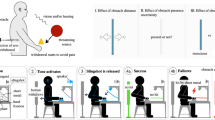Abstract
According to a classical conditioning view of hypnosis, responses used as criteria of hypnosis should develop via classical conditioning without the necessity for hypnotic induction. This hypothesis was tested by having experimental subjects first experience one trigram (e.g., “bex”) in conjunction with heavy objects and another trigram (e.g., “pob”) in conjunction with light objects. Control subjects had the trigrams associated with rough and smooth tactual stimuli in a random manner. The test for conditioning was an adaptation of standard arm lowering and levitation procedures. During the test, the subject was instructed to imagine one trigram in the left hand and the other trigram in the right hand. Objective bilateral arm movement in the conditioned direction, subjective reports of feelings of heaviness and lightness, and qualitative characteristics of experimental subjects’ behavior led to the conclusion that hypnotic behavior was conditioned to the trigram.
Similar content being viewed by others
References
BARBER, T. X. 1965. Measuring “hypnotic-like” suggestibility with and without “hypnotic induction”; psychometric properties, norms, and variables, influencing response to the Barber Suggestibility Scale (Bss). Psychological Reports, 16, 809–844.
BARBER, T. X. 1969. Hypnosis: A scientific approach. Princeton: Van Nostrand-Reinhold.
BOLLES, R. C. 1975. Learning theory. New York: Holt, Rinehart & Winston.
BRAY, C. W. 1928. Transfer of learning. Journal of Experimental Psychology, 11, 443–467.
CORN-BECKER, F., WELCH, L., & FISICHELLI, V. 1949. Conditioning factors underlying hypnosis. Journal of Abnormal and Social Psychology, 44, 212–222.
DAS, J. P. 1959. A theory of hypnosis. International Journal of Clinical and Experimental Hypnosis, 7, 69–77.
DAS, J. P. 1969. Verbal conditioning and behavior. Oxford: Pergamon.
DELPRATO, D. J. 1977a. Observing covert behavior (“mindreading”) with Chevreul’s pendulum. The Psychological Record, 27, 473–478.
DELPRATO, D. J. 1977b. Pavlovian conditioning of Chevreul’s movement. American Journal of Clinical Hypnosis, 20, 124–130.
EDMONSTON, W. E., Jr. 1967. Stimulus-response theory of hypnosis. In J. E. Gordon (Ed.), Handbook of clinical and experimental hypnosis. New York: Macmillan.
ELLSON, D. G. 1941. Hallucinations produced by sensory conditioning. Journal of Experimen tal Psychology, 28, 1–20.
HUDGINS, C. V. 1933. Conditioning and the voluntary control of the pupillary light reflex. Journal of General Psychology, 8, 3–51.
HULL, C. L. 1933. Hypnosis and suggestibility. New York: D. Appleton-Century Co.
KANTOR, J. R., & SMITH, N. W. 1975. The science of psychology: An interbehavioral survey. Chicago: Principia Press.
MENZIES, R. 1941. Further studies of conditioned vasomotor responses in human subjects. Journal of Experimental Psychology, 29, 457–482.
MUNN, N. L. 1932. Bilateral transfer of learning. Journal of Experimental Psychology, 15, 343–353.
SACHS, L. B. 1971. Construing hypnosis as modifiable behavior. In A. Jacobs & L. B. Sachs (Eds.), The psychology of private events. New York: Academic Press.
SALTER, A. 1949. Conditioned reflex therapy. New York: Capricorn.
SARBIN, T. R., & COE, W. C. 1972. Hypnosis: A social psychological analysis of influence communication. New York: Holt, Rinehart & Winston.
SPANOS, N. P., & BARBER, T. X. 1972. Cognitive activity during “hypnotic” suggestibility: Goal-directed fantasy and the experience of non volition. Journal of Personality, 40, 510–524.
WATERS, J. E., & KODMAN, F. 1962. Abstract conditioning. Journal of Psychology, 53, 441–452.
WELCH, L. 1947. A behavioristic explanation of the mechanism of suggestion and hypnosis. Journal of Abnormal and Social Psychology, 42, 359–364.
YOUNG, P. C. 1941. Experimental hypnotism: A review. Psychological Bulletin, 38, 92–101.
Author information
Authors and Affiliations
Rights and permissions
About this article
Cite this article
Holmes, P.A., Delprato, D.J. Classical Conditioning of “Hypnotic” Arm Movement. Psychol Rec 28, 305–313 (1978). https://doi.org/10.1007/BF03394540
Published:
Issue Date:
DOI: https://doi.org/10.1007/BF03394540




